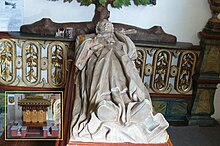Bernard of Wąbrzeźno
Bernard of Wąbrzeźno | |
|---|---|
 Tomb in Lubiń Koscianski | |
| Personal | |
| Born | Błażej Pęcharek 25 February 1575 |
| Died | 2 June 1603 (aged 28) |
| Religion | Catholic |
| Nationality | Polish |
| Organization | |
| Order | Order of Saint Benedict |
Bernard of Wąbrzeźno, born Błażej Pęcharek (born 25 February 1575 in Wąbrzeźno, died 2 June 1603 in Lubiń) – was a Roman Catholic priest and a Benedictine monk from the Benedictine Abbey in Lubiń.
Biography
Bernard was one of eight children of Pawła Pęcharka, the mayor of Wąbrzeźno, and his wife Dorothy of Sasin.[1] After graduating from the parish school at the age of 12, he was sent by his father to the Jesuit College in Poznań.[1] At the college, he distinguished himself for his selfless love of his neighbors and his compassion for the sick and the poor.[2] At the age of 24 he entered the novitiate in the Benedictine abbey in Lubiń, where he soon became master of novices at an unusually young age due to his ability to relate to young people.[1][2] His goal was to teach in a Catholic school during a period of great turmoil in the church, with many parishes leaving the church and becoming protestant churches.[3]
Bernard lived in the abbey for only four years.[3] He advanced to the priesthood in 1602,[3] and died in the abbey on June 2, 1603, in the odor of sanctity, probably of tuberculosis.[1][2] According to written biographies, he often spent many hours in vigils and was always the first to prayer, and eager to perform hard work.[2] He was remembered for his great love of the spitirual life.[3]
Beatification
After Bernard's death, many people came forward to testify of the miracles he had performed and that miracles had appeared at his grave.[1][4] Starting in the 1730s, the Archbiship of Poznań began collecting materials to produce biographies and testimonies of the miracles of Bernard.[2] After his death, the documents needed for the process of beatification were filed in Rome.[4] However, many of the Vatican archives were lost during the occupation of Poland by Napolean's Army at the turn of the 19th century, including some of the testimonies of the bishops of Poznań.[1][2][4] Further attempts were made in later years, but were interrupted during the Partitions of Poland, and the wars and occupations of Poland during the first and second world wars.[4] In 1968, the Metropolitan Archbishop of Poznań, Antoni Baraniak, formed a historical commission to resume the process.[2] However, due to the deaths of members of this and other committees, the work slowed.[2] In the early 2000s, attempts to restart the process and collect the necessary documentation resulted in the initiation of the beatification process on March 18, 2009 in Poznań.[4][5]
Legacy

A common legend associated with father Bernard was that in around 1603, he arrived in the town of Grodzisk Wielkopolski from the Benedictine monastery in Lubiń to find the residents starving and the town's wells depleted.[6][7] The brewery was the primary source of income for the city and the hospital.[8] Bernard prayed for the wells, and blessed the source, and a new source of water suddenly filled the Old Market Well. Legends claimed that the newly refilled well had the ability to make whoever drank from it healthy again, and the beer that was produced from the water was far superior to any of the beer the brewers had been able to produce before.[7] The well became a municipal treasure and was given credit for the commercial success of the town's breweries over the centuries to follow.[6] Between the years 1620 and 1815, the residents of Grodzisk would make an annual pilgramage to Bernard's tomb, walking the approximately 80 miles to bring a huge barrel of the beer that they made from the well as a show of gratitude.[4][7][8] The tradition was resumed in 2003, on the urging of Henryk Szymanski, the mayor of Grodzisk Wielkopolski.[9] On September 5, 2009, the city unveiled a 2-meter sculpture of Father Bernard next to the Old Market Well.[9]
See also
References
- ^ a b c d e f "Życie Sługi Bożego Ojca Bernarda z Wąbrzeźna [Lifelong Servant of God, Father Bernard of Wąbrzeźno]" (in Polish). Benedyktyni Lubiń. Retrieved 27 January 2016.
- ^ a b c d e f g h "Lubiń: pielgrzymka do grobu sługi Bożego o. Bernarda z Wąbrzeźna [Lubin: Pilgrimage to the Tomb of the Servant of God, Bernard of Wąbrzeźno]" (in Polish). Katolicka Agencja Informacyjna. Retrieved 28 January 2016.
- ^ a b c d Meissner, Karol (2004). "Ojciec Bernard z Wąbrzeźna [Father Bernard of Wąbrzeźno]" (in Polish). Przewodnik Katolicki [The Catholic Guide]. Retrieved 28 January 2016.
- ^ a b c d e f Matyjek, Jerzy (2003). "400-lecie śmierci sługi Bożego o. Bernarda z Wąbrzeźna [400th Anniversary of the death of the Servant of God, Bernard of Wąbrzeźno]" (in Polish). niedziela.pl. Retrieved 28 January 2016.
- ^ "Hagiography Circle: 1603". The Hagiography Circle. Retrieved 27 January 2016.
- ^ a b Szmelich, Wiktor (1994). "O historii i sposobie wytwarzania unikalnego piwa grodziskiego [The history and unique manufacturing method of Grodzisk beer]" (PDF). Przemysł Fermentacyjny i Owocowo-Warzywny (in Polish): 7–10. Retrieved 22 Oct 2015.
- ^ a b c "The Legend of Bernard of Wąbrzeźno". Instytucja Kultury Samorządu Wojewodztwa Wielkopolskiego. Retrieved 22 October 2015.
- ^ a b "Grodzisk Weilkopolski - History of the Town" (in Polish). City of Grodzisk Weilkopolski. 2013. Retrieved 22 October 2015.
- ^ a b "Grodziski Bernard" (in Polish). City of Grodzisk Weilkopolski. Retrieved 27 January 2016.
